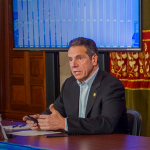World’s 11th-Largest Economy Hearts Renewable Energy
One key state is New York State, which by some measures would be the world’s 11th-largest economy if it was an independent country. On Friday, April 3, New York announced the passage of enabling legislation for its new clean power plans. If that date rings a bell, April 3 is the same day that seven top oil and gas executives went to the White House to discuss the plight of their industry.
If that’s not a clapback, nothing is.
Along with the now-familiar goal of creating jobs and fighting climate change, the new clean power plan makes the connection between renewable energy and economic recovery from the COVID-19 crisis.
To that end, the so-named Accelerated Renewable Energy Growth and Community Benefit Act creates the nation’s first ever “Office of Renewable Energy Siting.” The idea is that more private sector investment will be attracted more quickly, by tailoring the state’s approval process to fit renewable energy projects. The legislation also provides for reducing financial risk, helping to attract more private sector dollars that might otherwise go elsewhere.
In addition, the legislation takes grid planning and transmission into account.
Renewable energy developers anticipating a willy-nilly land rush may want to hold their horses, however. The new legislation provides for environmental oversight and community benefits. It also incentivizes renewable energy projects that repurpose abandoned commercial sites, brownfields, landfills, former industrial sites, and other abandoned or underused sites.
Walking The Climate Walk & Chewing The COVID-19 Gum
In announcing the new plan, New York seems determined to prove that it can walk and chew gum at the same time — in other words, that the public health crisis is not an opportunity to move backwards on climate action.
“We continue to act aggressively to protect the environment and our communities through our ongoing programs to reduce the greenhouse gas emissions that contribute to climate change,” said New York State Environmental Commissioner Basil Seggos, even as the state continues an all-hands-on-deck effort to stop the spread of COVID-19.
A Renewable Energy Model For Other States To Follow
Don’t be surprised if other states embark on a similar plan to speed up renewable energy development.
The problem is that conventional siting and permitting processes are primarily designed for large, centralized fossil fuel power plants (hydropower being a key exception). Today’s wind and solar industries, in contrast, are characterized by a wide range of outputs, applications, and siting opportunities.
The pump is already primed for the idea to spread. New York is on the advisory board of the newly launched 100% Clean Energy Collaboration, a state-based effort that includes California as well as New York and other clean power leaders. The new initiative was announced by the Clean Energy States Alliance on, you guessed it, April 3.
New York was also previously tapped by the US Department of Energy to lead a national consortium to accelerate wind energy development, so there’s that.
Speaking of the Energy Department and wind energy, New York and CESA were not the only ones trolling the oil and gas industry last week. The Energy Department also did its part, with not one but two separate press releases announcing new wind energy initiatives.
As for the Keystone XL pipeline, developer TC Energy (aka TransCanada) seems to have bitten off more than it can chew.
The company seemed on the verge of restarting construction last week, only to push the date back to the middle of April.
For that effort, all they got was this lousy downgrade from Moody’s, which cited significant “environmental, social and governance” issues that could bleed over from the Keystone XL project to impact the company’s financial stability as a whole.
Moody’s sour outlook is not an outlier. Leading global investors began dumping fossil fuel stocks before the COVID-19 outbreak and the hurt isn’t over yet.
If Keystone XL is the canary in the fossil fuel coal mine, it ain’t over until it’s over. But come on, it’s over.





